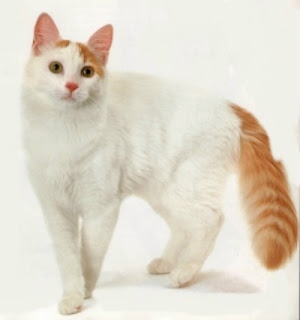Despite age and sex, as adults, individuals should convey an overall impression of a well balanced and well proportioned appearance in which no feature is exaggerated to foster weakness or extremes. These cats should appear alert and healthy, and be well groomed. Males should be large and imposing, females medium to large and well balanced. These cats should not be restrained too tightly, but should be handled with a firm and gentle pressure. As they are very intelligent and alert cats, they feel more secure and perform best when allowed to stand on their own on the table (if temperament allows).
 |
| Turkish Van |
Turkish Van Cats Head:
Shape: Large to medium size. Broad in males, moderately broad in females. Modified wedge with rounded contours and high cheekbones. Forehead slightly rounded. Allowances must be made for
jowling in the males. Head is slightly longer than it is wide. The face should not look foxy or rounded.
Eyes: Large, walnut to peach pit shape, set slightly oblique. Color is amber, blue or odd eyed. Moderately large, a rounded aperture slightly drawn out at the corners, set at a slant, equidistant from the outside base of the ear to the tip of the nose. Eyes should be clear, alert and expressive. Allow
for faded eye color and greenish cast to amber eyes in cats over 18 months of age. Rims are pink unless colored from random spotting.
Ears: Moderately large to large, set fairly high and well apart; the inside edge of the ear is slightly angled to the outside with the outside edge fairly straight but not necessarily in line with the side of the face; wide at the base. Tips are slightly rounded. Insides should be well feathered. Chin: Rounded somewhat, with an even bite.
 |
| Turkish Van |
Muzzle: The muzzle is neat, rounded, and proportionate to head, with a definite but not sharp whisker break (must be felt in full-coated cats). Profile: Slight dip below eye level marked by a change in direction of hair growth. Nose has a slight downward curve, but not so pronounced as to be a Roman profile. Neck: Medium short and muscular. May have full ruff with winter coat in mature adults.
TURKISH VAN BODY:
Torso: Sturdy and long. Full chest and substantial musculature. No hard planes or angles to shape of body. The rib cage is somewhat rounded (no slab sides). Size is large and imposing in males, females
proportionately less so. Kittens do not have the hard muscular feel of adults. Mature males should exhibit marked muscular development in the neck and shoulders. Shoulders should be as far apart as head is wide. Body tapers slightly to a strong pelvis. Allow for loose skin between the back legs.
Boning: Medium, well-muscled all over. Legs and Feet: Medium length forelegs with hind legs slightly longer. Medium boned with strong trim muscles. Neat, round feet with toes tufted. Tail: The tail is a brush or plume, medium-length and in proportion to the cat. Hair is at least 2 inches long in adults with a full brush.
TURKISH VAN COAT:
Length: Semi-long with no wooly undercoat. Due to the extremes in climate of their native region, the breed carries two distinctive coat lengths and allowances must be made for the seasonal coat. The
summer coat is short, conveying the appearance of a shorthair except for feathering of tummy and britches and is not as soft. The winter coat is substantially longer and thicker. Facial fur is short. A
frontal neck ruff and full brush tail become more pronounced with age. The above description is that of a mature adult, allowances must be made for shorter coats and tail hair on kittens and young adults. Texture: Soft, with the feel of cashmere. Individual hair is fine, water resistant and has a slight stand-away quality, particularly in winter. Winter coat is fuller, longer and softer.
TURKISH VAN COLOR/PATTERN and SOLID DIVISION:
Color: Solid white cats should be free of any evidence of color. All nose leather/paw pads are pink.
Pattern: Solid white cats should be free of any evidence of pattern.
 |
| Turkish Van |
TURKISH VAN ANY COLOR WITH WHITE DIVISIONS:
Color: White with Turkish Van Pattern markings. All traditional colors, may be tabbied or not, and are true to color description. All nose leather/paw pads are pink unless colored in patches by random spotting. Since the white spotting gene is present, you may also see white patches in the colored areas or a small white tail tip. Lockets do not apply. Pattern: Van pattern only, which is a blazed head patch and colored tail on white. Markings are ideally confined to the head and tail, but up to 20 percent of the cat (includes head and tail) may be colored with random spotting as long as it does not detract from the van pattern. A blaze (a white streak up the nose) to at least between the front edge of the ears is desirable. Allow for extended color on head or rump. Color on the tail should be continuous from base to tip. In tabbied colors, it should be ringed and darker above than below. Color may extend up rump.
TURKISH VAN PENALIZE:
General: Any evidence toward extremes (i.e., short cobbiness or svelte, fine boning); flat profile.
Particolor: Color over more than 20 percent of the cat; lack of facial blaze. Solid: Yellowing on the coat.
TURKISH VAN WITHHOLD ALL AWARDS (WW):
General: Definite nose break, poor condition. Any Color with White Divisions: Total absence of color on the head or tail; bicolor pattern. Solid: Any color other than white. Any spot of color on the body, head or tail, except that which is allowed on any other white cat of other breeds.







